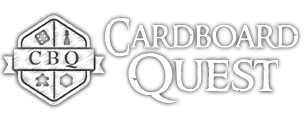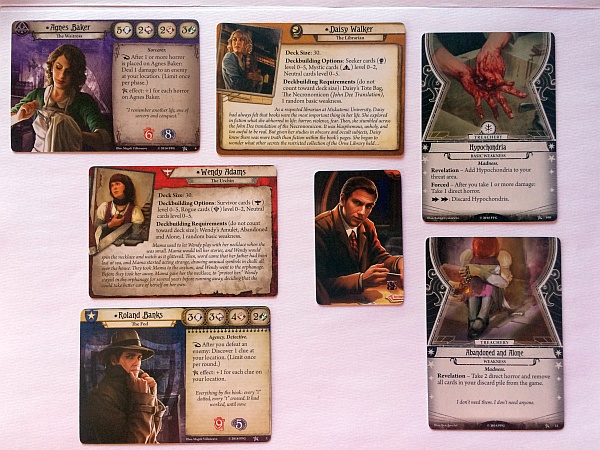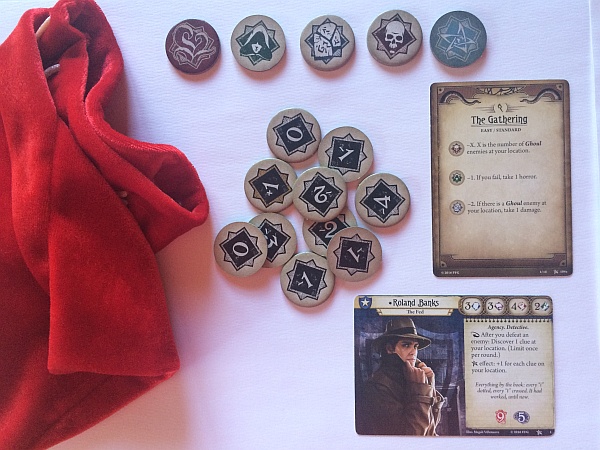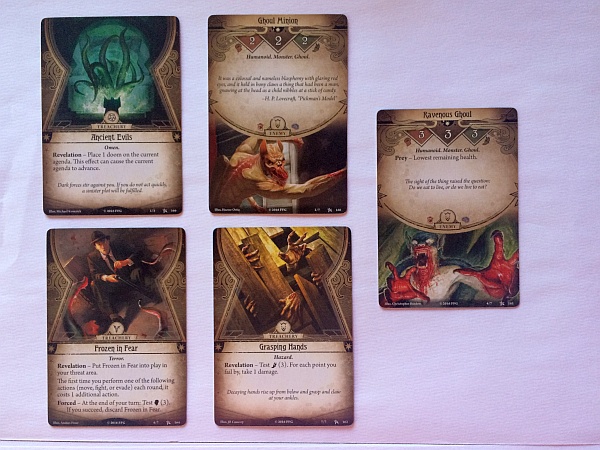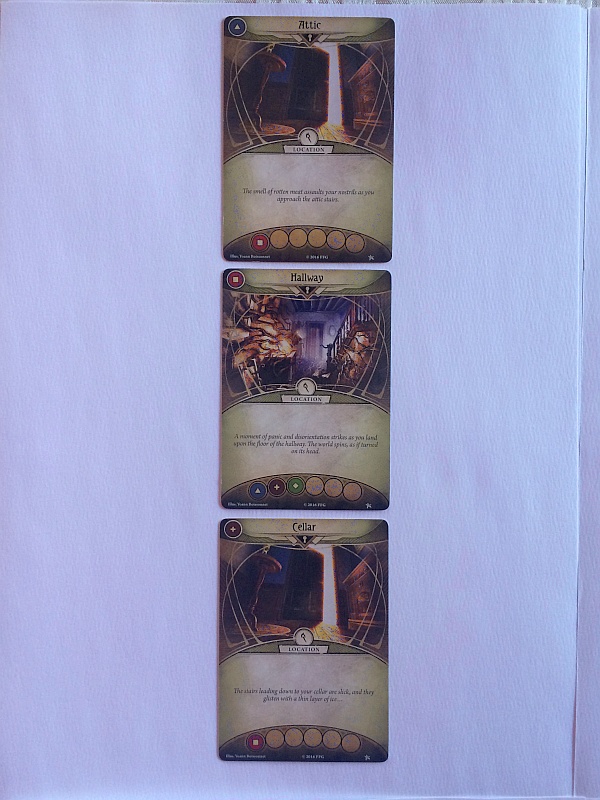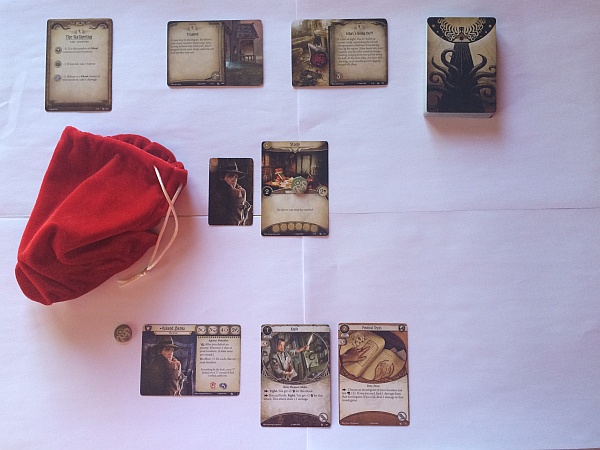Arkham Horror: The Card Game Review
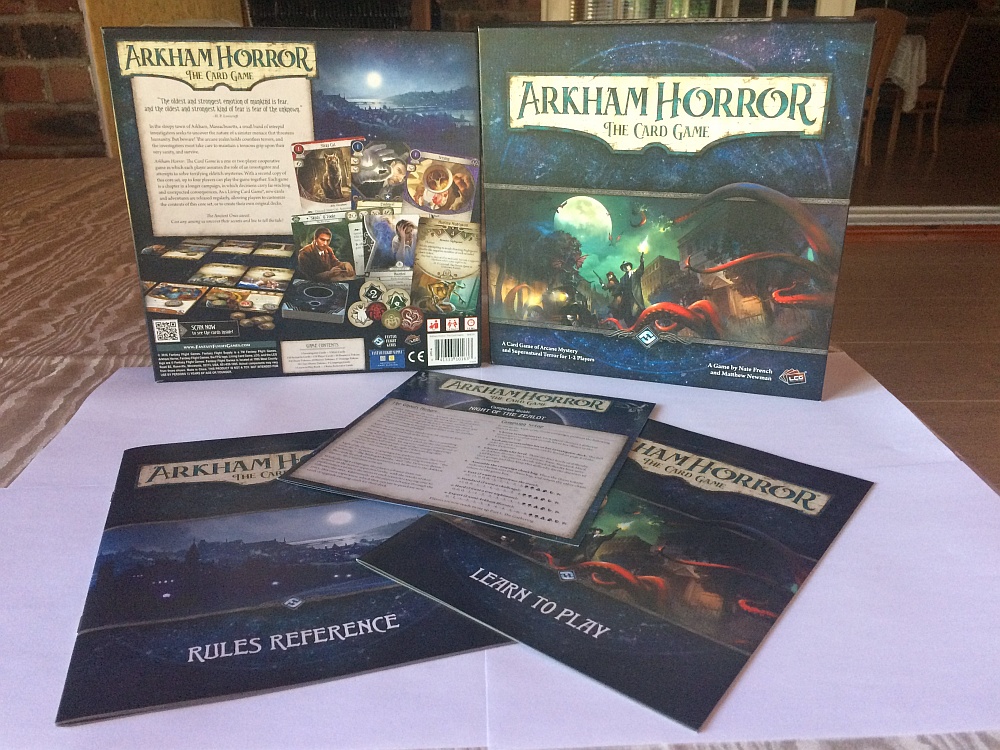
What is it? You've raced to close arcane portals wreaking havoc upon the sleepy town of Arkham. You've fought against the ancient plots of the Elder Gods in cities spanning the globe. You've pried open doors and and lockpicked cabinets in mysterious mansions. And now, horror has come for the LCG. And this time, we may just want to open our arms and welcome the end of the world with tidings of great joy.
I was always the kid with the darker shade of clothes growing up. I feasted in my youth on the darker emotions of terror, fantastical demonic stories of entities that would feed upon on the various cultures’ children around the world when the sun set. I would spend hours reading over origin stories of otherworldly arachnids through to wailing werewolves and admire all art depicting the darker side of the veil. Some of my earliest introductions to board games were playing Arkham Files games, exploring the mysteries of Mansions of Madness First Edition and later traversing the world in Eldritch Horror, and their claws played a large role in my immersion in the hobby. Needless to say, among us all here at Cardboard Quest, there was never going to be a contest as to who would be reviewing this title. And personally the hype was almost tangible to those I spoke to of the Dark Lord’s message before the good book arrived almost 2 weeks ago by Raven.
Arkham Horror: The Card Game is a cooperative Living Card Game set in the Arkham Files universe for 1-4 players where players take the roles of investigators looking to solve the mysteries caused by the power of the Elder Gods, and by doing so save towns and ultimately the world from being devoured. Each player will take control of a unique character constructed of a deck of 30 cards with traits from 2 factions and complete with unique abilities and tragic flaws. Similarly to other Arkham Files games, players will investigate various locations to gain clues in order to progress through the scenarios while battling fearsome terrors and rushing to find answers before Doom devours us all. “I’ve played this all before in every Cthulhu game from Fantasy Flight Games” I hear you saying to me, and you wouldn’t be wrong, but what Arkham Horror: The Card Game offers is the most immersive way to experience the narrative of H.P. Lovecraft’s world in a game yet.
Designers Nate French & Matthew Newman worked together before on the Lord of the Rings: The Card Game and have been integral to the Living Card Game line of products from Fantasy Flight Games. The aim with AH:LCG is to wed the narrative of an RPG with the strong customisable deck and hand management mechanics in an unholy matrimony and give birth to a campaign that will evolve from game to game. In this core box, you’ll find 5 different investigators with 5 different character classes for you to create your deck from, to play through a three scenario campaign called Night of the Zealots, with a narrative thread connecting them all. The brash ex-fed Roland whose starter deck comprises of Guardian (fighting and defense) and Seeker (Investigatory and Realism) cards coupled with his special .38 caliber pistol is simply one of the possible character decks. However, in the vain of Lovecraft’s lore, no character is untainted by the darkness they have seen in their life and so players will start with two weakness cards in their deck. One general, such as Amnesia, and in keeping with the character of Roland the “Cover Up” card which refers to the guilt he has of corruption in his soul. Much like great narrative RPG characters, each investigator has strengths and weaknesses to drive their narrative.
In the beginning each scenario of the Campaign book will set the scene and instruct you how to layout the game. They are comprised of location cards, Act Cards, Agenda Cards and an Encounter deck. Act cards will drive the narrative of the campaign and give the players instructions for their current objective in the scenario. Players advance through the scenarios by following the instructions, often finding enough clues to trigger the next Act card as they discover more information about the evil that is afoot or by killing particular monsters plaguing an area. The Agenda deck explains the current threat facing the investigators and advances when sufficient doom tokens are in play, with additional doom tokens being added to the Agenda card each turn, as well as encounters also accelerating doom. Once sufficient doom thresholds are met on the card, the peril…. becomes more perilous and can cause the end of your plight. Advance through all the Act cards to succeed or watch doom propel your team towards the gaping maw of the Ancient ones.
You’ll do this by moving between exploration location cards in the city of Arkham and equipping your investigators with weapons, skills, traits and allies to help them investigate, fight or just survive the relentless onslaught of the evil released from the encounter deck each turn. Each round, Doom will advance as the forces of evil work behind the shadows, each investigator will then draw from the encounter deck and be forced to put monsters into play or simply face a horrific situation that they need to overcome with an RPG style skill check. Players will then each take 3 actions allowing them to move, investigate, put a card into play by paying the resource cost, perform actions relating to character cards they have put into play, gain resources, draw cards or engage and fight or evade enemies that they are engaged with. Players can perform the same action as many times as they wish, allowing freedom for players to do what needs to be done inside the time constraints (Looking at you Warhammer Quest). Almost all the critical actions needed to advance the story require skill checks and while your characters retain the trusted attributes of Intellect, Combat, Agility and Willpower, how you test them is the first of many things I love about the evolution of the Arkham Files games.
Arkham Horror: The Card Game introduces the Chaos bag, and an assortment of tokens labeled everything from +1 through to -4 and a variety of other symbols, such as tentacles, skulls, elder signs and broken tablets. For your skill check, you’ll be presented with a number to equal or better and an attribute of your character that you’ll need to test against. You’ll check your current skill level, add any particular bonuses or deficits you have from character cards in play and then draw a random token from the bag. The final result is calculated as your modified skill level, + or minus the number from the bag. Should you equal or surpass the level required, you succeed. Otherwise you may suffer the wrath of evil forces or simply feel the shame of missing the opportunity to solve the mystery. The brilliance of this system is three fold for me. You’re able to alter the difficulty level of the campaign you’re playing to provide extra challenge or relieve frustration by changing the tokens in the bag. Players are afforded a greater feeling of control as they choose their own fate from the bag instead of the “unfair” randomness of dice, and lastly you’re weaving additional mechanics into the narrative. Remember I spoke of the tablet, skulls and other token symbols? Well the results of these vary according to the scenario that you’re playing. For example when investigating a house infested with Ghouls, the skull would be stated to be -X: X being the number of Ghouls at this characters location. This not only integrates skill checks as part of the narrative but also allows the designers to constantly provide fresh tension to skill checks depending on the story they are trying to tell.
Need to find clues? You’ll test your intellect against the shroud value of a the room you’re in to gather the possible evidence to be found there. When engaged with Monsters, you’ll need to either fight them by beating their combat value or evade them by being agile and exhausting the creature for that round before doing anything else and providing the creature with an opportunity to attack you mercilessly. Need a little help to buff your chances of success? Most cards have the option to be discarded to increase your skill level should the cards have a matching symbol to the test you’re trying to achieve. If your fellow players are sharing the same location, they can also commit a single card from their hand to increase your chances of success as well! The Chaos bag gave each player at our table a sense of further control of their fate and added some interesting moments to our games.
Another stellar element that has been added are the location cards and the way they are laid out for players. Location cards begin face down, with a brief description of what investigators currently know about that location before they have explored it. Upon moving to the location, the card is flipped and whatever secrets, creatures, perils or benefits are at the location are now seen, as well as how many clues are possibly found at this location. When multiple locations are out, icons on the locations indicate which other locations are adjacent to the current location and where an investigator can move to at the cost of an action. This creates a specific scenario board out of cards, bridging the gap to traditional board elements all within the card system of Fantasy Flight Games. Each scenario has set cards and locations that make narrative sense to the players that explore them, doing away with the random location decks constructed by various difficulty levels of cards and ignoring the importance of narrative congruence.
Character development is crucial throughout the campaign narrative and each character decks feel unique with a mixture of two styles of cards with weaknesses and strengths that grow as you build your deck. You’ll need to manage your cards in play with investigators only being able use limited assets in line with realistic RPG style character constraints. Gone are the Arkham Files days of Roland carrying a shotgun and two pistols with a machete, as AH:LCG limits you to the reality of only have two hands and a single neck for a single amulet. You’ll make important decision when constructing your decks and as you spend experience points gained between scenarios to purchase new and more powerful cards to replace those you begin the story with. Not only will you gain experience, but at the end of each scenario, you’ll be offered a choice to make, which will impact your character development for the rest of the campaign. It’s a beautiful touch to immerse you in the world of Arkham Horror.
Much like any thematic gaming experience, this is a world to immerse yourself in to get the most enjoyment out of this game. As you read each Act and Agenda card as they advance, as you read each location you explore and as you notice how each creature and encounter card is tightly woven to match the current scenario, I found it easy to immerse myself in the Arkham Horror world. Yes, the random thematic gaming mechanics of chance are greatly improved in my mind, but they are still the main elements of the game as you can find yourself down to half health within two turns by simply pulling a -4 from the Chaos Bag. Heroes don’t always live and good doesn’t always triumph and much in the theme of the game there hope may sometimes be in short supply. What I discovered in Arkham Horror: The Card Game was the horror narrative card game that I had been waiting for, with the care taken to incorporate all elements of a scenario to fit the narrative and give me moments of elation and despair, while always enticing me to draw the next token. Needless to say I don’t want to ruin any narrative elements, but for the players who focus on the details of the writing they will see the little things have been added that have been missing in most games of this type up until now.
With the Art Direction and Production, FFG have once again exceeded any and all of my expectations. Excellent card stock and some of the most chilling, grotesque and terrifying art all bring the world of H.P. Lovecraft to life with imagery that cannot be called anything but works of art, and it is a definite contender for best art of the year in my mind.
The game is not without its flaws and some consistent FFG criticisms accompany my impressions of this title. The lack of an actual bag in this box set is something that will immediately disappoint most players, especially since FFG have produced bags for their Arkham Nights event held to launch the game. Whilst I used an Orleans bag, I really recommend anyone picking up this title to get yourself a velvet bag for the chaos tokens as a cup will just leave you thirsty for more. Whilst players can construct some decks for solitaire and 2 player games in a single core set, there are limitations on the combinations of investigators that you can build due to a single card of most types included in the base set. To open up all combinations of investigator types for 2 players and to play with 3-4 players you’ll need 2 core sets immediately, which leaves you with some duplicate cards. And while I understand the economics of the decision, it’s always a tough one for players to swallow. Lastly, due to the nature of the campaign structures moving forward in the LCG format, this isn’t going to be a title where you will possibly skip certain mythos expansions packs. Each campaign begins with a deluxe box with 2 scenarios, and the remainder of the narrative will be told over the following 6 mythos packs totaling 8 scenarios. Not buying means missing the narrative, which unlike other LCGs makes this possibly the most expensive Fantasy Flight series to buy into.
Despite these flaws, this gaming experience is a leading contender for my game of 2016. It’s a combination of the quick setup, the narrative details and the reworking of the skill check system all woven together into one of my favourite themes in a true story telling experience. I’ve happily played through the same scenario multiple times with different characters, all yielding narratives with enough difference that I enjoyed each of the sessions. Each scenario felt different, with extended mechanics and choices and subtle theme changes, each monster and location had details that drew me into the world and each card had me staring at the art for ages before placing it back on the table. I know that the game mechanics are still there but I’ve had a spell cast on me to make me enjoy every narrative the cards, weave not in spite of the mechanics but because of them. I know that the darkness is not for everyone, but each time I play it feels like this experience is for me. And I cant wait to grab my flashlight and side arm to venture to wherever danger threatens Arkham inside the immersive world Nate French and Matthew Newman have created. If you love any of these elements as much as I do, you may find a tentacle plunging into your heart as well, whispering to let it call you home.

Pros:
- That card art.
- That card art again, because it deserves two pros
- Actions and consequences highly thematic
- Strong Cohesive narrative elements
- Customisable
- Chaos bag
Cons:
- Requires buying into the narrative
- Replayability may not appeal to all
- Game Mechanics still luck based
- Have to buy all expansions for the narrative
